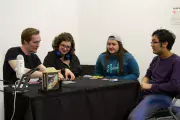
New Game Art & Design major challenges crunch culture

"Crunch culture" is taking its toll on individuals in the gaming industry.
Characterized by passionate and talented artists and designers working under grueling conditions, "crunch culture" is contributing to blockbuster games and corporate profits but often to the detriment of the physical and mental health of those same passionate and talented workers.
CCAD is addressing this concern in the boardroom, classroom, and at the gaming table.
CCAD’s new major, Game Art & Design, launched in fall 2020. Classes in the field previously existed within the Animation major, but Assistant Professor Elizabeth Keegan welcomed the opportunity to both hone in on what she calls the language of game play as well as expand students' understanding of how their varied skills can be applied in this method of storytelling.
"At CCAD we're surrounded with different entry points, different realms of thought, where students can get a broad tool kit to be able to address design concerns no matter what their role is," Keegan says.
Chair of Animation and Game Art & Design Charlotte Belland says the major has been a longtime coming. "The Game Art & Design major has been self-incubating at CCAD for years, maybe decades. We want to send graduates into the world with leadership capabilities so they can speak for voices that have not had representation within the industry."

As a preview of sorts, a group of Keegan's students developed a tabletop, card-based, role-playing game called "100 Hours Till Launch" in the spring of 2020. The admittedly-more-than-a-little-meta game finds four players on a team with a deadline to develop a new game.
"I was asked to look at the concept of healthy creativity, especially in gaming. We were having trouble coming up with a campaign that seemed like a good fit, when I had a conversation with Matthew Tarulli, co-founder of game publisher Odam Publishing, who suggested we make a game out of it," Keegan says.
"One of the challenges of talking about crunch culture is that, in a group of people very passionate about their work, it's natural to want to put all of your time and energy into something," Tarulli says.
Most of the students had little to no experience in game development, so Keegan and Tarulli had them play numerous board games, asking students to consider things like mechanics of game play, actions of players and characters, communication among players and intent.
"As we were introduced to concepts of how to make a board game, we thought about visuals and about game play, but Matt also awakened us to ideas like how to achieve a feeling or emotion and how to structure that within a game," says Noah McKee (Illustration, 2020).
Chumani Bowser (Animation, 2020) said the project had her thinking in new ways. “As an animation major, my first thought was, 'How do I make it look pretty?'"

"When building the game we had to take care to not make it too 'on the nose,'" Catherine Lastowka (Animation, 2021) explains. "Throughout the game, the purpose is to work on jobs. You have 100 hours until a game is supposed to launch. This is a crunch. There are expectations. It's a commentary on how goals can be achieved with balance, but we didn't want to spell things out plainly. We didn't want game play to feel like there was an agenda."
McKee concurs, saying the group worked hard to allow crunch and an investigation of if it is the most efficient way to get something done.
Sean Howard (Animation, 2021) says some game play—commuter cards, for example, help determine how an individual player gets to work impacts their productivity— was "ripped straight out of real life."
"The art, the writing came from a real place. The crunch is not only statistics, but we saw it happen," Howard says.
Keegan confirmed the crunch in her invitation to some members of the CCAD and Columbus gaming communities to play a first edition of the game. "In the middle of development, the values espoused by '100 Hours Till Launch' were put to the test," Keegan says. "The need for self-care was made starkly apparent when a deadly pandemic, stay-at-home orders, and work stoppages went into effect. You may notice some cards in this print and play version have incomplete or uncolored line art. In these times, for this project, we don't consider that a failure: we consider that a point of pride."
Throughout the fall semester, the foundation class of 14 students have jumped right into developing games based on topics ranging from rule constraints in board game design to storytelling in interactive fiction. They have explored game creation through the lens of both tabletop and digital platforms. Students are, much like their senior level peers, exploring a range of design topics in theme, mechanics, and meaningful choice. Alongside the practice of design, students develop key practice in game art production. From 2D game art to 3D, students engage in developing essential skills for making game ready assets.
“I am proud to see the enthusiasm of our first cohort of Game Art & Design students, and I look forward to playing their games,” says Belland. “Our Game Art & Design Major will lift up voices, engage challenging topics, and bring new audiences into the art of play.”
Learn more about the Game Art & Design program at CCAD or apply here.
Photos; from top:
CCAD students and Assistant Professor Elizabeth Keegan, second from left, at the MakerX The Columbus Maker Expo, February 29, 2020. Photo by Ty Wright.
The CCAD student-designed 100 Hours Till Launch game. Photo by Ty Wright.
CCAD students test 100 Hours Till Launch in the spring of 2020: (left to right) Noah McKee explains the game rules while Grace Thorsen, Kara Aquila, and Andrew Jung play as the game is streamed online for viewers to watch and comment. Photo by Ty Wright.

Post date
December 17, 2020